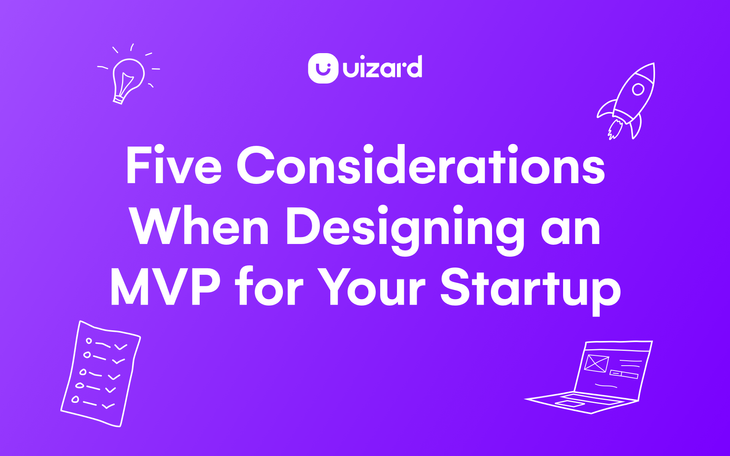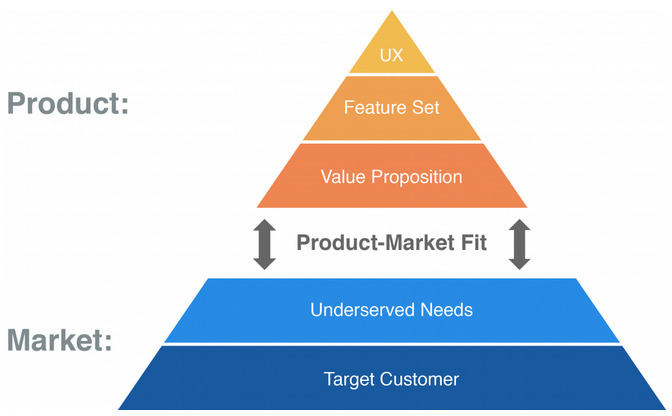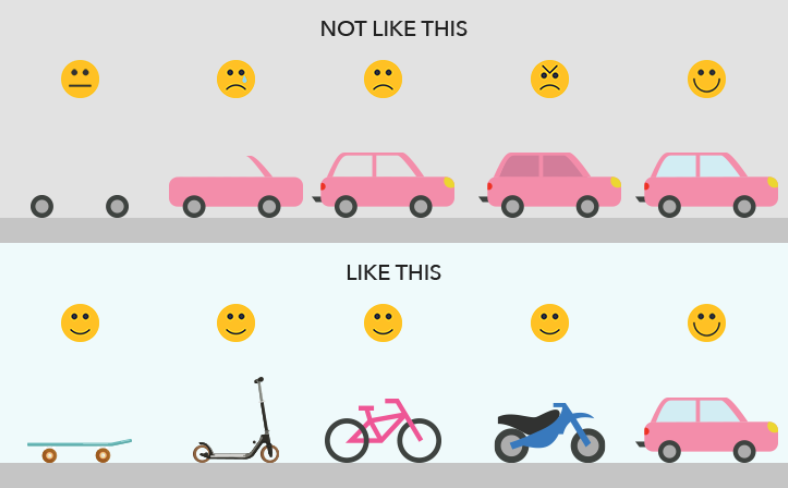Five considerations when designing an MVP for your startup

In our step-by-step guide to creating an MVP, we defined the minimum viable product as the process of introducing a basic version of a new product into the market in a limited capacity for testing, analysis, and iteration. Sounds simple enough, right? But what does it really take to design an MVP in practical terms? What are the core considerations of MVP design? And how can you ensure you avoid the common pitfalls that most founders experience?
In this article, we talk through several essential considerations for designing your MVP so that it remains tightly focused on its single most important goal: helping you to crystalize your products purpose, establish its value proposition and, in turn, help you to grow and build a sustainable and thriving business long-term.

Skip to section:
MVP design and design thinking
5 considerations for MVP design
Something to consider: The MVP design and design thinking
The enthusiastic adoption of the principles of the Lean Startup movement in parallel to Design Thinking is a direct response to the failings of the traditional product development process. Founders would spend months, or even years, developing the most perfectly formed version of their big, brilliant idea and then finally launch it into the market — most likely with massively expensive marketing fanfare — and wait for the crowds. Did this work? Sure, sometimes. But more often than not, after the fanfare died down, the crowds moved on to the next party.
What these companies failed to address wasn’t just “Can we build this?” but “Should we, and if we do, will it be successful?” Launching an MVP is a way of engaging with a critical feedback loop — Build, Measure, Learn — that not only minimizes risk, but also has the potential to spare you the costly resources of fully developing an untested concept.
The fundamental goal of designing and launching an MVP is to find product-market fit, which is to say, that magical sweet spot where your value proposition uniquely addresses strong market demand and resolves unmet user needs, and your user experience delivers on both successfully. Or, to put it more simply: to find product-market fit is to find people that are happy to pay for what you’re offering.

The Product-Market Fit Pyramid (notice how UX is at the top?!)
5 considerations for MVP design
Even though, as we discussed in our guide to creating an MVP, an MVP can take many different forms, designing one is still rooted in foundational UX principles and practices. That is to say that any version of your product or service you put out into the world stands to meet real human needs, solve real human problems, and speak to real human values. Being able to clearly identify and understand your core audience underpins each of the five considerations to keep in mind as you’re designing your MVP, but also the whole of your user experience:
- Focus on the essential value your product offers
- Challenge your assumptions about what a user needs
- Start with the smallest thing that will show success
- Remove anything that doesn’t directly contribute to what you need to learn
- Find your early adopters
1. Focus on the essential value your product offers
It’s not just about getting to market quickly; it’s about showcasing your unique and differentiated value proposition. How and why are you the only brand able to deliver this product or service in these specific and tangible ways? If you were to draw a side-by-side matrix comparing your features to your top two competitor’s features, where are you incomparable? Another way to look at this is through a popular innovation exercise: where are you the first, the best, or the only in your market space? When designing your MVP, those are the features you want in front of your users first.
2. Challenge your assumptions about what a user needs
Perhaps you’ve heard this one before. Henry Ford is famously quoted as saying, “If I had asked people what they wanted, they would have said faster horses.” The point is to think beyond feature sets and focus on pains and gains.
Using prototyping tools for prototyping and iteration is critical to revealing these insights and should inform how you prioritize the highest-value features to include in your MVP. As we’ve discussed above, homing in on the concept of value is essential to designing an MVP. If you’ve done your work in gathering and applying user feedback from incremental prototypes, then your MVP will present a strong hypothesis about how the value you’re delivering aligns with a customer’s own values.

The MVP Mindset (Source: Peerbits)
3. Start with the smallest thing that will show success
An MVP should be tightly focused, but that doesn’t always have to mean a constrained or compromised user experience. As illustrated by the Concierge example, an MVP can also be a test of scale. Splash out on the most comprehensive and polished experience you can afford to make an unforgettable first impression. But start with just one audience, or one offering, or one geographic market. Prove that you can deliver exceptional value, and then see if you can repeat again and again without any loss of quality.
4. Remove anything that doesn’t directly contribute to what you need to learn
As a founder who is eager to bring their vision, in all its glory, to the masses ASAP, we understand that it goes against every instinct to take things away from your user experience, things that you know people want and that you know you can implement. Thinking back to the iPhone example we shared earlier, you cringe just thinking about being on the receiving end of a flood of complaints about dead batteries and dropped calls.
But the thing is, what you didn’t know (you’re Steve Jobs in this example, just go with it) is whether people wanted a whole computer in their pocket. But you had a hunch. A hypothesis. So, the batteries could wait for a later release.
Gut-check every feature in your MVP by asking yourself in what way it serves to validate your key hypotheses. Remember that you will iterate your way forward; each new release should be designed to test your next hypothesis.
5. Find your early adopters
“If you build it, they will come” is a lovely, yet (as you should understand by now), naive belief. What you really need to do is build a community of early-adopting users. This can (and probably will) be friends, family, and coworkers who understand your product isn’t ready for prime time but will be invested and motivated in helping you get there. Many of the tactics in an Audience Building MVP can be applied in the other types, as well. Inviting users into your process by demonstrating that you value their input is like recruiting your own cheerleading squad who’ll be waving you on and celebrating with you when you reach the finish line.
MVP design with Uizard
Putting something out into the world before it’s “done” can feel scary and like even more of a gamble than we’re willing to take. Even though we know better, we’re all secretly hoping that we’re the exception that proves the rule, and that we’ll get it right on the first try. But when it comes to designing and launching an MVP, you have to reframe what it means to get it “right.” When your goal is to learn, there’s no way to get it wrong, only to get it better next time.
Ready to start creating and defining your minimum viable product? We're here to tell you that all great ideas start with a basic sketch; you're almost certainly going to want to draft out a few wireframes; and a functional prototype is almost certainly going to form part of your UX design process. Luckily, you can do all this with Uizard, and the best part? You can sign up for free right now!
Uizard's UI templates and tools are built with non-designers in mind. From sketch to wireframe to prototype, Uizard is ideal for founders who are iterating their way forward to an MVP. Sign up to Uizard for free to give it a try!
